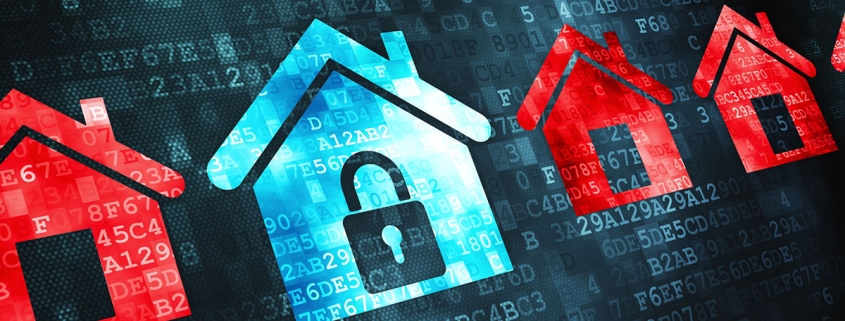Very few people say to themselves, “I want to spend the day learning about home security systems!”
Until a break-in happens. And statistically speaking, it is likely to happen.
2 million home burglaries are reported in the US every year.
A home invasion robbery happens every 13 seconds, roughly four burglaries a minute. Doing the math, that is nearly 6,000 burglaries every day.
But, 9 out of 10 burglars said that if they encountered an alarm or home security system, they would not attack the home.
Some people are tempted to buy the first home security system they find or invest in the most expensive system with the most up-to-the-minute technology instead of wading through the myriad of options that are available. After all, it doesn’t matter what the system looks like as long as you have one, right?
Not necessarily.
Your home security needs are more important than selecting a system based on one factor. Choosing a system based on price or technology or intimidation sometimes overlooks the primary reason why a home security system is necessary – your security.
That is why this guide is necessary. We have broken down, in easy to understand terms, the important factors to consider when choosing a home security system. By the end, you will be able to make an informed decision for your home, your family and your budget.
While it’s not the most exciting topic, it is important that you first answer the question:
Technically speaking, what is a security system?
In the early years of home security, wires were connected to magnets which were then attached to a door or window. When the magnets were in contact with each other, like when the window or door was closed, they formed a “closed loop.” When the door or window was opened, and the magnets were apart, they formed an “open loop.” The wiring connected to the magnets was also connected to the main control panel. If the system was armed and a loop in a particular zone was opened, it would send an alert to the control panel, and it would trigger a bell or alarm.
As simple as the technology seems, the same concept still governs most home security systems today with one significant difference. Most systems are now wireless giving the control panel the ability to monitor whether a loop is closed or open without running wires throughout a home. Some systems can also be armed or disarmed remotely using a smartphone app. Some are monitored by a call center where information is interpreted based on the type of alarm that is sounded and the zone where it occurs.
In short, a home security system includes:
- The main control panel
- A method to arm or disarm the system
- A communicator in the case of monitored systems that relays information to authorities
- in the event of a breach
- Door and window sensors
- Optional motion sensors, glass break sensors and environmental sensors that monitor breaches as well as carbon monoxide, water or fire.
- Optional video cameras to verify that a break in or accident has occurred
- An alarm or siren
So, you may be wondering…
What do the security system components do?
Each component of a home security system has an important function. Understanding each one can help you make the best decision which to include in your system.
Control Panel
Today’s control panels are highly sophisticated minicomputers. They can be armed or disarmed either remotely or via a fob or keypad (more about them below). The control panel continuously monitors the status of all window and door sensors, video cameras, environmental sensors, and motion detectors so it can communicate any breach to a central monitoring system.
User Interface
The user interface is just a fancy way of describing the way a person communicates with the control panel. This can take any number of forms. Keypads, key fobs (like what you would use to lock or unlock your car), or smartphone apps are all different types of user interfaces that let people arm and disarm their security system.
Door & Window Sensors
Even the most basic system has a series of window and door sensors. These sensors consist of two separate parts, one installed on the door or window and one installed on the door jam or window sill. When the door or window is closed, the two parts create a closed loop security circuit (remember that?). When the door or window is opened, the magnetic field is broken opening the loop. While some sensors are surface mounted or placed where they are visible to someone looking at the door or window, others can be hidden in the actual window or door and frame that holds it.
Motion Sensors
Let’s assume, for a second that someone miraculously bypasses your window or door sensors and enters your home.
Too bad, say goodbye to your grandmother’s jewelry, right?
Wrong!
Motion sensors add a layer of security that protects any given space in your home. When the alarm is armed, if someone crosses an area where a motion sensor is monitoring the zone, the alarm will sound. Motion sensors are particularly useful in rooms where valuables are kept or areas in larger homes that are not typically used.
Surveillance Cameras
Surveillance cameras do more than just monitor your babysitter or keep intruders from lurking around your doors and windows. They can offer added protection against theft everywhere in your home from your front door to your garage door. Today’s models are available in both wired and wireless models and can interface with a mobile app that allows you to see any activity in your home from your smartphone. Curious when the kids walked in the door? A surveillance camera linked to your smartphone can tell you the minute they walk in. Want to know who is stealing your mail? A surveillance camera you can access via your control panel can tell you. Surveillance cameras can also offer footage of the perpetrator and a good look at their getaway car should a home invasion occur.
High-Decibel Alarm
Wise parents teach their children to yell “Fire!” instead of “Help!” if someone is trying to kidnap them because people are more likely to look for a fire than they are toward a cry for help. A high-decibel alarm is an equivalent of yelling “Fire!” in the whole neighborhood. Loud enough for all of the neighbors to hear, a high-decibel (in other words, really, really loud) alarm lets everyone know that something has happened while scaring would-be intruders away.
Still with us? By now you’re probably wondering, with all of these components in place:
What Happens if There is a Break-in?
Let’s be honest. Even with the best security system in your home, there is a chance that someone will try to break in.
Take Joe Burglar trying to break into a home without a security system.
One Saturday night, when he’s pretty sure no one is home, Joe tries to break into your home and steal anything valuable that isn’t nailed down. He decides to first try the front door because if you left it unlocked, his job is easy. When Joe Burglar finds it locked, he decides to go around to the back door through your unlocked gate. When the door is locked, he doesn’t waste an opportunity in the shadows and simply breaks the window next to it with the brick paver under his foot. With access to your house, he proceeds to carry out anything he can to his waiting car outside. Driving away, he rests assured that no one will discover his crime until they return home.
Now, let’s take the same criminal who tries to break in a home that has a security system.
Let’s assume your home is equipped with surveillance cameras, a high-decibel alarm, a home security app that is connected to your smartphone, and remote monitoring by an alarm company.
Joe walks to your front door to check the door. Immediately, the motion triggers a surveillance camera in your doorbell that gets a clear and accurate picture of his face in the porch light. This triggers an alert to your phone where you see that someone has tried to enter your home. You alert the alarm company who notifies authorities before Joe even attempts to go around back. Still, he walks around the side of the house where he is once again picked up by surveillance cameras. Joe scales the locked fence gate, tries the back door and finds it locked. He picks up a brick paver from underfoot and smashes the window next to the door only to be deafened by a high-decibel alarm. Startled, he tries to scramble back to the front yard only to be met by the authorities who promptly arrest him. In court, the video evidence from the surveillance cameras debunks his alibi that you asked him to look after the house while you were gone.
As nice as it sounds to not only identify the would-be burglar but have authorities arrest him a short time later, some people are reluctant to pay a regular fee to have their homes professionally monitored.
Instead, they sit there thinking to themselves:
I’m Handy, Can’t I Just Rig a Security System Myself?
In short, yes. Non-monitored security systems are available in home improvement stores that can be installed on your own if you have basic skills with tools and a little bit of networking know-how. Depending on the system, DIY security systems may have a high-decibel alarm, multiple sensors and even surveillance cameras that are triggered by someone ringing the doorbell. The one thing they do not have is the ability to contact police, fire, emergency medical personnel, or other first responders without the homeowner doing it themselves. In other words, you are still responsible for reporting a potential crime to the authorities should you see or hear something suspicious.
Professionally monitored security systems have the added benefit of additional eyes and ears on your home, 24 hours a day, seven days week. If any of the closed loops on your windows or doors are opened without first disarming the system, the monitoring center will try to contact you or your emergency contact before notifying the authorities, just in case you forgot to turn off the alarm.
In the event of an emergency, a professionally monitored security system will notify the authorities in your area. Sure, you could call 9-1-1 if someone tries to break into your home while you are there, but monitoring centers go beyond calling the police in the event of an intrusion. If your home is equipped with environmental sensors that detect fire, water, and carbon monoxide and connected with a professional monitoring system, these professionals can notify fire, ambulance and first responders in the event of an emergency outside of theft.
Imagine protecting your family not only from bad guys trying to get in but common household emergencies.
Picture elderly family members staying in their own homes, protected by additional eyes and ears.
Still not sold?
Well, what about this:
Homes without security systems are three times more likely to be burglarized.
Shocking, isn’t it?
Think about it, burglars, by nature, are opportunistic criminals. They want an easy target, one that doesn’t require too much work or too much risk on their part. Homes with security systems, especially those that have professional monitoring systems, make it nearly impossible for would-be burglars to steal your property and leave unnoticed. Rather than risk it, they’ll move on to a home that is not as well protected.
Right now, you’re probably asking:
How do they know?
They play the odds.
Currently, only 14 percent of homes in the US are protected by home security systems. Statistically speaking, a burglar has an 8 out of 10 chance that the home they will break into will not have a monitored system in place.
Another way they know?
Advertising.
Professionally installed security systems often come with window stickers and yard signs warning would-be thieves about their chances of being caught should they try to hit your house. Some people have argued that, rather than going to the expense of installing a security system, why not just put a sticker on your window and a sign in your yard? You could, but you also wouldn’t have the peace of mind that comes with a fully protected home.
Just for good measure:
More Shocking Statistics
59 percent of home burglaries happen during the day.
Homes with a lot of cover from trees, fences, and plants are the most commonly invaded properties.
Most burglaries happen in July and August. Whether it’s the love in the air or the frigid temperatures,
February, oddly enough, has the fewest number of burglaries on average.
The vast majority (more than 95 percent) of burglaries involve some force. Intruders commonly kick down the door or break a window to gain access to the home.
I know, I know, after all of this, you still might say to yourself:
“I live in a safe neighborhood. Do I need a security system?”
For a minute, let’s assume that your neighborhood is a veritable Fort Knox. Gated and guarded, you rest assured every night that nothing could happen to your home.
The truth is, no matter how well guarded your front entrance, and no matter how observant your “concerned” neighbor is, no one will monitor your home the way a home security system will.
In fact:
Anyone can benefit from a home security system, even if security isn’t your primary concern.
In reality, break-ins happen more often than you think. Even with 6,000 burglaries happening every day nationwide, few are reported on the evening news. Incident reports that were once reported in the local newspaper have reached fewer and fewer readers as people turn to the internet for their information. Fortunately, crime continues to be reported on specific websites designed to keep neighborhoods informed.
Even if you never experience a break-in, a monitored system will give you peace of mind in a host of other environmental emergencies. Specialized sensors that detect water, fire or carbon monoxide alert a monitoring center that, in turn, alerts your family to a problem. Not only do you stay safe in the event of an accident, monitored environmental sensors can potentially and effectively save your home and personal belongings in an emergency.
You’re completely sold on the idea of a home security system, right?
Now, you have to ask yourself:
What is the Best Security System for me?
The best security system for you is the one that is designed around your lifestyle, your home, and your budget. It should provide you with a sense of safety and confidence without being so complicated that you cannot easily use it. After all, why have a home security system if you don’t know how to arm it?
First, ask yourself four questions.
- Do you want to have a professional install your security system or do you want to do it yourself? Understanding that DIY home security systems are not professionally monitored, some DIY systems can offer monitoring via a smartphone app or even wireless control. Keep in mind, installing a security system is not the same as building bookshelves. It may require some skill in networking, locksmithing, carpentry, or even electrical work.
- Do you want your system to be monitored by a central monitoring system? This may determine the answer to the first question. Most monitoring companies will not work with systems that have not been professionally installed by a licensed technician. In researching different monitoring options, ask how the company will support your system once it is installed including service and repairs.
- What are your security concerns? Do you have windows that are accessible without a ladder? How many exterior doors do you have? Are there particular areas of your home that don’t have a lot of traffic or areas where valuables are kept? Do you want environmental sensors as well that monitor fire, flood, and other environmental emergencies as well as intrusions?
- Perhaps the biggest question you need to answer is how you want to control the system? Are you hoping for a wireless system or is your home pre-wired for home security? Do you want to have the flexibility to control your system with your cell phone? Do you want to have the option of going with another company if you are not satisfied with the service you receive from the first one?
You’re likely reeling at the possibilities.
In reality, the best home security system for you will probably combine sensors, motion detectors, surveillance cameras, and off-site home monitoring. If you travel a lot, a total-home automation system that allows you to turn on appliances and lights from a smartphone app will give you the ability to make it appear as though someone is home. Even people who work long hours find a home automation system that lets them set the thermostat, lock the doors, monitor their children through surveillance cameras, or send medical assistance to your home whether you are there or not offers the perfect piece of mind.
The options are endless but don’t be overwhelmed.
As you begin to consider your home and family’s needs, there will be some features that will jump out at you as “must haves” while others will appear less essential. It is perfectly acceptable to start with a basic security system that addresses the most vulnerable areas of your home first. Just remember to purchase a system that you can always add to later, in case your needs change.
But, let’s get down to dollars and cents.
How Much Does a Home Security System Cost?
Let’s break it down.
Installation
Installation refers to the sensors, cameras, control panel, and other components of a system as well as the process of putting a home security system in a home. While do-it-yourself systems are more widely available than ever, many home monitoring companies will only work with systems that have been installed by certified technicians. Some even insist on having their technicians install a security system so they can be assured that it is set up for their systems, software, and service.
Your cost for installation will vary based on:
- Whether you install it yourself or hire someone to do it for you.
- Whether the installation is included in a monitoring contract.
- The type of system you wish to put into your home.
- The number of sensors, cameras or other components required to meet your needs.
Monitoring
Once the system is installed, if you choose to have it monitored by professionals, you will pay a monthly or annual monitoring fee. Varying from $30 to $100 a month, monitoring technicians can detect if your home has been breached, if there is a fire, water emergency or other problem in your home or if there is a medical emergency that requires first responders. A monitoring system can then notify the proper authorities and even monitor the situation until they arrive.
Aside from the obvious installation and monitoring costs, there are two other less addressed costs associated with home security.
Consider Your Potential Losses
Victims of burglary offenses suffered an estimated $3.6 billion in property losses in 2015. The average dollar loss per burglary offense was $2,316. Yes, in some instances, nothing of value was stolen, but in others the losses were much, much higher. Take some time to inventory your valuables and determine how much it would cost to replace these items. Keep in mind that burglars tend to steal things that are easy to carry and can be easily sold. Electronics, antiques, jewelry, and cash are all likely to be stolen in a robbery. Would your replacement cost be higher than the average of $2,316? Could you replace these items at all? Some things with sentimental value can never be replaced in their original form simply because they wouldn’t have the memories attached. Others are impossible to find, replicate, purchase, or create.
The Emotional Cost of Burglary
Even if you don’t have items that are necessarily valuable, keep in mind that over one-quarter of all crime victims develop post-traumatic stress disorder as the result of their experience.
Which means, you have to ask yourself:
How much is your peace of mind worth?
Even if you adopt the attitude of, “It’s just stuff,” it is important to realize that home security systems are just as much for protecting people you care about than they are about protecting the things you care about. Everyone under your roof will sleep better at night and feel more secure during the day if you have the added layer of protection a home security system provides.
That’s not to say a home security system can’t be affordable.
Right?
How do I get a home security system without breaking the bank?
Home security companies normally make pricey systems more affordable in three ways:
Reducing up-front costs
Many home monitoring companies are willing to reduce the up-front costs associated with purchasing a home security system as long as you sign a contract for their monthly monitoring service. This is a fantastic option for people who want to secure their home, but don’t have the cash for hefty equipment, installation and activation costs. However, these systems do not always offer all of the bells and whistles you may want. Some companies offer a low installation and activation fee, but only offer their proprietary window and doors sensors that cannot be used with another company or a system that cannot be expanded later on. Be sure to ask about both portability and expandability before signing a service contract.
Offering DIY systems
Wait, DIY? Don’t monitoring companies frown on DIY systems? Not necessarily. Some monitoring companies offer an equipment package of easy-to-install sensors and a basic control panel. Since you are using the monitoring company’s equipment, you are also using their proprietary software which they can troubleshoot should something go wrong. Even though these systems tend to carry larger up-front costs, many people like the freedom of not having a service contract that prohibits them from shopping around should they become disenchanted with their monitoring provider.
Insurance Savings
Let’s not forget, that installing a home security system will save you on your home insurance. Many companies provide discounts of up to 20 percent should you have a monitored security system. Insurance companies know that a professionally monitored system adds an incomparable layer of protection to your home. They figure that a lower chance of being robbed means a lower likelihood of filing an insurance claim. As a result, insurances are willing to pass along the savings to you. Depending on where you live and your homeowner’s insurance premiums, the savings you experience as the result of a home security system can pay for monthly monitoring costs.
While installation, equipment, and monthly monitoring fees certainly can vary, a basic security system will cost you far less than what the average burglary.
Just remember:
Home Security is More Than the Name Suggests
Not only does a home security system give you an added piece of mind that your home, valuables, family, and pets will be protected should someone attempt to cause harm, it offers you unparalleled features that you cannot get anywhere else. Remotely lock doors, arm your system, monitor who comes to your door, check in on the kids or pets, or even turn on lights or appliances while you are gone with the touch of a button. Combine this with a second set of eyes that never sleep from a 24/7 professional monitoring center, and you have unprecedented levels of security at a lower price than you might expect.
Now, armed with this information, you can make a decision based on your budget, your home, your needs, and your wish list. Still, have questions? Ready to get started? Contact us for a free in-home consultation to discuss your security needs.






